Isotoma
Annual or perennial herbs, producing milky sap. Leaves alternate (in Victoria), sometimes appearing distichous, or rarely, rosetted at base, entire or toothed. Flowers axillary and solitary or in terminal cymes (sometimes raceme-like), bisexual and protandrous or rarely unisexual; bracteoles inconspicuous, sometimes absent. Hypanthium usually oblique; corolla slightly (in Victoria) to distinctly zygomorphic, occasionally 2-lipped, lobes usually spreading, subequal or the upper 2 smaller, tube entire or shortly slit on the upper side; staminal filaments partly adnate to corolla-tube; anthers connate in a tube, the lower 2 anthers with an apical seta and (in Victoria) short penicillate hairs, the upper 3 anthers glabrous at apex or rarely with short apical hairs; ovary 2-locular; stigma 2-lobed, the lobes c. hemispherical, surrounded by a brush of tiny hairs. Fruit a capsule or indehiscent, disintegrating with age; seeds numerous, reticulate or weakly ridged, or occasionally smooth.
About 16 species (including undescribed species), 14 endemic to Australia, 1 extending to New Guinea and 2 in New Zealand.
Isotoma was reduced by Wimmer (1953) to a section of the otherwise African and North American genus Laurentia, but Australian authors have followed the view of Melville (1959) that Isotoma should be given generic rank.
Australasian species of Hypsela are now included within Isotoma. The type of Hypsela from South America was synonymised with the type of Pratia and transferred to Lobelia (Lammers 1999) and consequently the remaining species of Hypsela, including the Victorian Hypsela tridens, cannot remain in Hypsela. The remaining species of Hypsela differ from the South American type by possessing filaments that are adnate to the corolla for at least half of its length. This condition is absent in Lobelia but present in Isotoma. The remaining species of Hypsela also have entire corolla tubes, a condition rare in Lobelia but common in Isotoma. Consequently, these remaining species of Hypsela were deemed most appropriately placed in Isotoma (Lammers 1999). The only major difference between the Australasian Hypsela species and Isotoma is the indehiscent fruit of Hypsela compared to the capsular fruit of Isotoma. However, dehiscence has been shown elsewhere in the Lobelioideae to be an inappropriate character to use to define genera (see note after Lobelia).
KEY TO GENUS
For key to this and related genera (Monopsis), see general key to the Campanulaceae.
Albrecht, D.E.; Walsh, N.G. (1999). Campanulaceae. In: Walsh, N.G.; Entwisle, T.J., Flora of Victoria Vol. 4, Cornaceae to Asteraceae, pp. 553–553. Inkata Press, Melbourne.
 Spinning
Spinning

